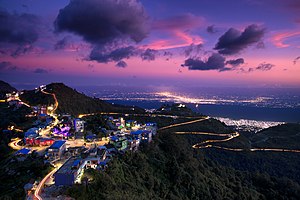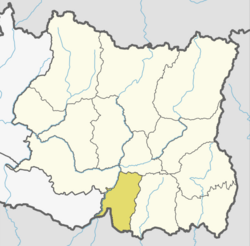|
Sunsari District
Sunsari District is one of 14 districts in Koshi province of eastern Nepal. The district is located in the eastern part of the Outer Terai and covers an area of 1,257 km2 (485 sq mi). According to the 2011 Nepal census, the population was 753,328.[1] The district headquarters is located in Inaruwa. The area was originally part of Morang District but became its own district in 1962 when Nepal was divided into 14 zones and 75 districts. Major cities in Sunsari district are Inaruwa, Itahari, Jhumka, Dharan, and Duhabi. Some religious places of this district are Budha Subba Temple, Ramdhuni, Chataradham, Baraha, Bishnupaduka, Dantakali, and Pindeshor Babadham. The lowlands of Limbuwan, present day Sunsari, Morang and Jhapa Districts was collectively known as Morang District since the time of King Mung Mawrong Hang of the 7th century.[2] AdministrationThe district consists of two Sub-metropolitan Cities, four urban municipalities and six rural municipalities.[3] These are as follows:[4] Sub-metropolitan citiesMunicipalitiesRural municipalitiesGeography and climate
Demographics
2021According to the 2021 Nepal census, 926962 people reside in Sunsari in 212545 households with average family size of 4.36.
Out of total population, 48.4% male and 51.6% Female. Education in Sunsari Early Childhood (4.6%) Primary Education (28.0%) lower Secondary (18.8%) SLC/SEE (12.2%) Higher Secondary (16.8%) Intermediate (12.6%) Graduate (3.7%) Post-graduate and above (1.5%)
In 10+2 or equivalent, 39.3% study management, 26.3% Education, 11.6% Humanities and 8.1 Science. 2011At the time of the 2011 Nepal census, Sunsari District had a population of 763,487. The most spoken language is Nepali: 28.8% spoke Nepali, followed by 28.5% Maithili.[7] Ethnicity/caste: 12.1% were Tharu, 11.5% Musalman, 9.2% Chhetri, 7.9% Hill Brahmin, 6.6% Rai, 4.3% Yadav, 4.0% Koiri/Kushwaha, 3.8% Newar, 3.4% Musahar, 3.2% Limbu, 3.1% Jhangad/Dhagar, 2.3% Tamang, 2.3% Teli, 2.2% Kami, 2.0% Magar, 1.6% Dhanuk, 1.5% Bantar/Sardar, 1.2% Chamar/Harijan/Ram, 1.1% Halwai, 1.0% Damai/Dholi, 1.0% Gurung, 0.8% Kathabaniyan, 0.8% Khatwe, 0.6% Gharti/Bhujel, 0.6% Majhi, 0.6% Mallaha, 0.6% Marwadi, 0.6% other Terai, 0.5% Terai Brahmin, 0.5% Dhimal, 0.5% Hajam/Thakur, 0.5% Sanyasi/Dasnami, 0.4% Dusadh/Paswan/Pasi, 0.4% Kulung, 0.4% Sarki, 0.3% Bantawa, 0.3% Bengali, 0.3% Gaderi/Bhedihar, 0.3% Kalwar, 0.3% Kewat, 0.3% Khawas, 0.3% Sarbaria, 0.3% Tatma/Tatwa, 0.2% Badhaee, 0.2% Chamling, 0.2% Dom, 0.2% Kayastha, 0.2% Kumal, 0.2% Kumhar, 0.2% Rajbanshi, 0.2% Rajput, 0.2% Sherpa, 0.2% Sudhi, 0.2% Sunuwar, 0.1% Amat, 0.1% Badi, 0.1% Baraee, 0.1% Bhote, 0.1% Danuwar, 0.1% Dhobi, 0.1% Kurmi, 0.1% Lohar, 0.1% Munda, 0.1% Nuniya, 0.1% Pattharkatta/Kushwadiya, 0.1% Punjabi/Sikh, 0.1% Rajbhar, 0.1% Rajdhov, 0.1% Sonar, 0.1% Thakuri, 0.1% Thulung, 0.1% Yakkha and 0.3% others.[9] Religion: 73.3% were Hindu, 11.5% Muslim, 6.9% Kirati, 4.4% Buddhist, 1.9% Prakriti, 1.5% Christian, 0.1% Jain and 0.4% others.[11] Literacy: 68.0% could read and write, 2.0% could only read and 29.9% could neither read nor write.[12] Former VDCs
See alsoReferences
External linksWikimedia Commons has media related to Sunsari District. |
|||||||||||||||||||||||||||||||||||||||||||||||||||||||||||||||||||||||||||||||||||||||||||||||||||
Portal di Ensiklopedia Dunia






